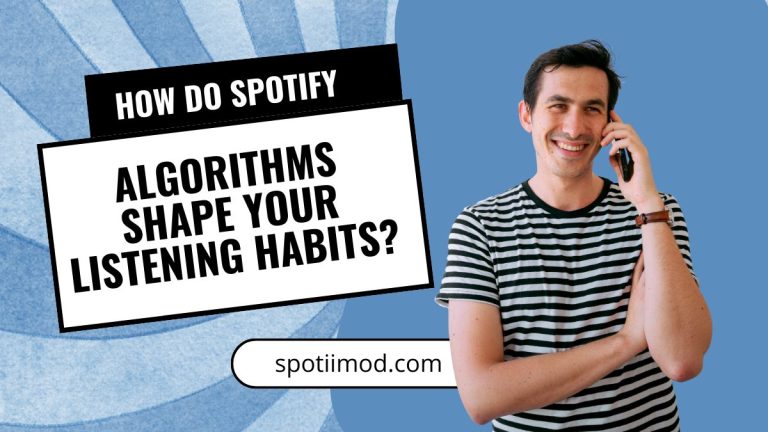Spotify Algorithms to Shape Your Listening Habits

Spotify algorithms allow users to easily access new trending music, the most famous playlists, and albums shared with social friends. This process is interesting in the Spotify application because it will help users find their favorite music on Spotify. It automatically imagines that users are interested in what type of songs. Then, it automatically forwards related music to users.
Users can easily get the most trending music or search for their favorite songs to listen to; it will give results in just a few seconds. Some AI tools help to automatically get new and user-interaction music. So you can also note Spotify algorithms: just listen to two or more related songs or music by the same musicians, and they will give you automatic playlists for related music or the same song by the singer that you mostly listen to.
Step-by-Step Guidance
Here is the Step-by-Step Guide to how you can shape your listening habits by using Spotify Algrothims;
1: Getting Regional information
Spotify algorithms will note user location, interest, and surrounding environment. Because in the age of social media AI tools are really giving amazing performance to note everything. With no regional locations, Spotify algorithms will note user age from Gmail or other account verification.
It will help to give age-related music that users are interested in. If you’re also a Spotify user then you can easily note the interaction of Spotify algorithms, when your surrounding environment is so cool or romantic Spotify will automatically give you the environment-related music.
2: Noting the interaction of users
That is the main noted feature by Spotify algorithms. There is noted user interest in what type of music he/she listens mostly and what type of tracks are skipped by users like what type of musicians are mostly listened to by users. When you’re skipping some type of songs or music of the same musician on Spotify.
You will never face the next time on the same account. Because there are fewer chances to face skipping tracks or music. In the other way if the user is enjoying the same type of music or songs of the same singer then other related songs will automatically come next.
3: The Presence of a Collaborative Filter
That filter mostly uses similar habits of users like some users have an interest in listening to sad songs, some emotionally related songs, or some hilarious music. That will be noted for ease of use and automatically select music to listen to in the next tracks or playlists.
Another is a content-based filter which also relates to the collaborate filter because when the user searches for some music on the searching tab it automatically notes the interest of the user. Then next time there is no need to search for singers or music because it will automatically come to your next playlist to listen and entertain.
4: Users Feedback
There are options for the like button or dislike button of every music or in the profile of musicians. Where users can easily give their review by clicking just on one button. After listening to the song you can click on the interested or not interested buttons as a review. Then Spotify algorithms will save your information and give you according to your review songs next time on the same account. So be careful to give your feedback on Spotify.
5: Noting listing Style
Skipping or listening to the same music more time is a pattern of the user. Because sometimes we listen to a song most of the time or download it permanently to enjoy. So it creates an easy way for the Spotify algorithms to note your feedback. So when you skip music or playlists then there are fewer chances to give you again to listen and on the other way when a user listens to a song two or more times then the same music will automatically come to the next.
6: Friendly Interference & Sharing
Sharing playlists or songs with social friends has a fantastic effect on noting user interest by Spotify algorithms. Some users create playlists or albums of favorite music and once share them to friends for increasing entertainment. After collection or sharing of music show the main focus of singers and music of user interest. Because everyone saves their favorite songs or shares them.
7: Trending Music
This application will automatically give you trending songs because Spotify algorithms are not sure according to user interaction. So after listening to trending songs you can give feedback by clicking the like or dislike button. After updating users can face boring songs or in which users have no interest so give your review to get your favorite music for further listening.
Pros and Cons of Spotify Algorithms
Here are the Pros and Cons of Spotify Algorithms;
Pros
Cons
Conclusion
Spotify algorithms are advanced technology in Spotify to note the main interest of users with the help of AI tools presented in the application. The main purpose of Spotify algorithms is to save feedback from users in the form of interest, not interest. And in future give them music related to interest. It will automatically note your age and surrounding environment to give you related songs.
Once users listen to a song two or more times or download it the rated music or singer will be in the next tracks of Spotify. In searching tabs, some filters note the interaction of searchers. Spotify algorithms make this application advanced and most used worldwide but with advantages, there are also some disadvantages of Spotify algorithms like facing limitations or updating to start again.
Also Read: Download Spotiflyer APK for free


![Spotify Mod Apk New Version Guidance and Tips to Enhance your listening experience [2025]](https://spotiimod.com/wp-content/uploads/2024/05/How-to-Block-Ads-on-Spotify-26-768x432.jpg)



